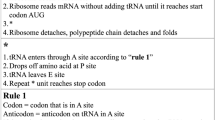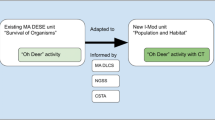Abstract
As computational methods are widely used in science disciplines, integrating computational thinking (CT) into classroom materials can create authentic science learning experiences for students. In this study, we classroom-tested a CT-integrated geoscience curriculum module designed for secondary students. The module consisted of three inquiry investigations that were age-appropriately translated from the computational practices of volcanologists who study tephra hazards and risks. We developed a domain-specific, block-code-based computational modeling environment where students carried out 1 of the 3 science practices in each inquiry investigation: experimentation, data visualization and interpretation, and modeling. We examined (1) student learning outcomes using pre- and post-tests and (2) student reflections on the computationally supported science practices surveyed at the end of each inquiry investigation during the module. Results indicate that students made statistically significant gains in science content as well as in computationally supported experimentation, data visualization and interpretation, and modeling practices. Over 80% of students identified different ways in which block coding supported their practices during inquiry investigations. Based on these findings, we discuss implications for the future development of computationally supported inquiry investigations in science.

Similar content being viewed by others
References
Benakli, N., Kostadinov, B., Satyanarayana, A., & Singh, S. (2017). Introducing computational thinking through hands-on projects using R with applications to calculus, probability and data analysis. International Journal of Mathematical Education in Science and Technology, 48(3), 393–427. https://doi.org/10.1080/0020739X.2016.1254296
Bonadonna, C. (2005). Probabilistic modeling of tephra dispersal: Hazard assessment of a multiphase rhyolitic eruption at Tarawera, New Zealand. Journal of Geophysical Research, 110(B3), B03203. https://doi.org/10.1029/2003JB002896
Brennan, K., & Resnick, M. (2012). New frameworks for studying and assessing the development of computational thinking. Paper presented at the 2012 Annual Meeting of the American Educational Research Association, Vancouver Canada.
Brown, J., Collins, A., & Duguid, P. (1989). Situated cognition and the culture of learning. Educational Researcher, 18(1), 32–42.
Chen, Z., & Klahr, D. (1999). All other things being equal: Acquisition and transfer of the control of variables strategy. Child Development, 70(5), 1098–1120.
Connor, C., Bebbington, M., & Marzocchi, W. (2015). Chapter 51—Probabilistic volcanic hazard assessment. In H. Sigurdsson (Ed.), The encyclopedia of volcanoes (2nd ed.). Academic Press. https://doi.org/10.1016/B978-0-12-385938-9.00051-1
Denning, P. (2007). Computing is a natural science. Communications of the ACM, 50, 13–18.
diSessa, A. (2001). Changing minds: Computers, learning, and literacy. MIT Press.
Dunbar, K. (1995). How scientists really reason: Scientific reasoning in real-world laboratories. In R. J. Sternberg & J. E. Davidson (Eds.), The Nature of Insight (pp. 365–395). The MIT Press.
Fennell, H. W., Lyon, J. A., Madamanchi, A., & Magana, A. J. (2020). Toward computational apprenticeship: Bringing a constructivist agenda to computational pedagogy. Journal of Engineering Education, 109(2), 170–176. https://doi.org/10.1002/jee.20316
Froyd, J. E., Wankat, P. C., & Smith, K. A. (2012). Five major shifts in 100 years of engineering education. In Proceedings of the IEEE (Vol. 100, Special Centennial Issue, pp. 1344-1360). IEEE.
Giere, R. N. (1988). Explaining Science: A cognitive approach. University of Chicago Press.
Graham, M., Milanowski, A., & Jackson, M. (2012). Measuring and promoting inter-rater agreement of teacher and principal performance ratings. Center for Educator Compensation Reform.
Grover, S., & Pea, R. (2013). Computational thinking in K-12: A review of the state of the field. Educational Researcher, 42(1), 38–43.
Grover, S., Pea, R., & Cooper, S. (2015). Designing for deeper learning in a blended computer science course for middle school students. Computer Science Education, 25(2), 199–237.
Gweon, G.-H. & Lee, H.-S. (2022). Applying deweyan perspective of inquiry to teaching experimentation using simulation. In C. Chinn, E. Tan, C. Chan, & Y. Kali (Eds.), Proceedings of the 16th International Conference of the Learning Sciences - ICLS 2022 (pp. 1281-1284). International Society of the Learning Sciences.
Hankinson-Nelson, L. (1990). Who knows: From Quine to feminist empiricism. Temple University Press.
Henderson, P. B., Cortina, T. J., Hazzan, O., & Wing, J. M. (2007). Computational thinking. In I. Russell & S. Haller (Eds.), Proceedings of the 38th ACM SIGCSE Technical Symposium on Computer Science Education (SIGCSE ’07) (pp. 195–196). Association for Computing Machinery. https://doi.org/10.1145/1227310.1227378
Hurst, T., & Smith, W. (2004). A Monte Carlo methodology for modelling ashfall hazards. Journal of Volcanology and Geothermal Research, 138(3), 393–403.
Karpatne, A., Ebert-Uphoff, I., Ravela, S., Babaie, H. A., & Kumar, V. (2019). Machine learning for the geosciences: Challenges and opportunities. IEEE Transactions on Knowledge and Data Engineering, 31(8), 1544.
Kastens, K. A., Manduca, C. A., Cervato, C., Frodeman, R., Goodwin, C., Liben, L. S., Mogk, D. W., Spangler, T. C., Stillings, N. A., & Titus, S. (2009). How geoscientists think and learn. Eos, Transactions American Geophysical Union, 90(31), 265–266.
Lave, J., & Wenger, E. (1991). Situated learning: Legitimate peripheral participation. Cambridge University Press.
Lee, H.-S., & Songer, N. B. (2003). Making authentic science accessible to students. International Journal of Science Education, 25(8), 923–948.
Lee, I., Grover, S., Martin, F., Pillai, S., & Malyn-Smith, J. (2020). Computational thinking from a disciplinary perspective: Integrating computational thinking in K-12 science, technology, engineering, and mathematics education. Journal of Science Education and Technology, 29(1), 1–8. https://doi.org/10.1007/s10956-019-09803-w
Li, Y., Schoenfeld, A. H., diSessa, A. A., Graesser, A. C., Benson, L. C., English, L. D., & Duschl, R. A. (2020). On computational thinking and STEM education. Journal for STEM Education Research, 3(2), 147–166. https://doi.org/10.1007/s41979-020-00044-w
Lye, S. Y., & Koh, J. H. L. (2014). Review on teaching and learning of computational thinking through programming: What is next for K-12? Computers in Human Behavior, 41, 51–61. https://doi.org/10.1016/j.chb.2014.09.012
Manduca, C. A., & Kastens, K. A. (2012). Mapping the domain of spatial thinking in the geosciences. Geological Society of America Special Papers, 486, 45–49.
Medunic, G., Chakravarty, S., & Kundu, R. (2022, July). Computational skills in geosciences higher education system for the 21st century. Paper presented at the 4th Croatian Scientific Congress about Geomathematics and Terminology in Geology, Zagreb, Croatia.
Miller, E., Manz, E., Russ, R., Stroupe, D., & Berland, L. (2018). Addressing the epistemic elephant in the room: Epistemic agency and the next generation science standards. Journal of Research in Science Teaching, 55(7), 1053–1075.
National Research Council. (2012). A framework for K-12 science education: Practices, crosscutting concepts, and core ideas (p. 13165). National Academies Press. https://doi.org/10.17226/13165
Newhall, C. G., & Self, S. (1982). The volcanic explosivity index (VEI) an estimate of explosive magnitude for historical volcanism. Journal of Geophysical Research: Oceans, 87(C2), 1231–1238. https://doi.org/10.1029/JC087iC02p01231
NGSS Lead States. (2013). The next generation science standards. The National Academies Press.
Ogegbo, A. A., & Ramnarain, U. (2022). A systematic review of computational thinking in science classrooms. Studies in Science Education, 58(2), 203–230.
Orton, K., Weintrop, D., Beheshti, E., Horn, M., Jona, K., & Wilensky, U. (2016). Bringing computational thinking into high school mathematics and science classrooms, 2, 705–712.
Pallant, A., Lee, H.-S., & Pryputniewicz, S. (2012). Students learn how adjusting variables in a dynamic model affects the entire system. The Science Teacher, 79(7), 39–42.
Papert, S. (1980). Mindstorms: Children, computers, and powerful ideas. Basic Books, Inc.
Quintana, C., Reiser, B. J., Davis, E., Krajcik, J., Fretz, E., Duncan, R. G., Kyza, E., Edelson, D., & Soloway, E. (2004). A scaffolding design framework for software to support science inquiry. Journal of the Learning Sciences, 13(3), 337–386.
Resnick, M., Maloney, J., Hernández, A., Rusk, N., Eastmond, E., Brennan, K., Millner, A., Rosenbaum, E., Silver, J., Silverman, B., & Kafai, Y. (2009). Scratch: Programming for everyone. Communications of the ACM, 52, 60–67.
Robins, A., Rountree, J., & Rountree, N. (2003). Learning and teaching programming: A review and discussion. Computer Science Education, 13(2), 137–172.
Shiflet, A. B., & Shiflet, G. W. (2014). Introduction to computational science: Modeling and simulation for the sciences. Princeton University Press.
Stieff, M., & Wilensky, U. (2003). Connected chemistry—Incorporating interactive simulations into the chemistry classroom. Journal of Science Education and Technology, 12(3), 285–302. https://doi.org/10.1023/A:1025085023936
Stroupe, D. (2014). Examining classroom science practice communities: How teachers and students negotiate epistemic agency and learn science-as-practice. Science Education, 98(3), 487–516.
Stroupe, D. (2015). Describing “science practice” in learning settings. Science Education, 99(6), 1033–1040. https://doi.org/10.1002/sce.21191
Tinker, R. F., & Xie, Q. (2008). Applying computational science to education: The molecular workbench paradigm. Computing in Science and Engineering, 10(5), 24–27.
Uzzo, S., & Chen, R. (2015). Integrating computational thinking and environmental science: Design based research on using simulated ecosystems to improve student understanding of complex system behavior.
Wang, C., Shen, J., & Chao, J. (2022). Integrating Computational Thinking in STEM Education: A Literature Review. International Journal of Science and Mathematics Education, 20(8), 1949–1972. https://doi.org/10.1007/s10763-021-10227-5
Waterman, K., Goldsmith, L., Pasquale, M., Goldenberg, P., Malyn-Smith, J., DeMallie, A., & Lee, I. (2018). Integrating computational thinking into elementary mathematics and science curriculum materials and instruction. Conference Proceedings. The Future of Education, 2018 https://conference.pixel-online.net/library_scheda.php?id_abs=3076
Waterman, K. P., Goldsmith, L., & Pasquale, M. (2020). Integrating computational thinking into elementary science curriculum: An examination of activities that support students’ computational thinking in the service of disciplinary learning. Journal of Science Education and Technology, 29(1), 53–64.
Weintrop, D., Beheshti, E., Horn, M., et al. (2016). Defining computational thinking for mathematics and science classrooms. Journal of Science Education and Technology, 25, 127–147.
Wilensky, U., & Stroup, W. (2000). Networked gridlock: Students enacting complex dynamic phenomena with the HubNet architecture. In B. Fishman & S. O'Connor-Divelbiss (Eds.), Fourth International Conference of the Learning Sciences (pp. 282-289). Erlbaum.
Wilkerson, M. H., & Fenwick, M. (2017). The practice of using mathematics and computational thinking. In C. V. Schwarz, C. Passmore, & B. J. Reiser (Eds.), Helping students make sense of the world using next generation science and engineering practices (pp. 181–204). National Science Teachers’ Association Press.
Wing, J. M. (2006). Computational thinking. Communications of the ACM, 49(3), 33–35.
Disclosure
Any opinions, findings, conclusions, or recommendations expressed in this material are those of the authors and do not necessarily reflect the views of the National Science Foundation.
Funding
This material is based on work supported by the National Science Foundation under grant no. DRL-1841928.
Author information
Authors and Affiliations
Corresponding author
Ethics declarations
Ethical Approval and Consent to Participate
This project was reviewed by Ethical & Independent Review Services. It is deemed that the proposed involvement of human subjects met the criteria for an exemption from further IRB approval beyond an initial assessment. Informed consent was obtained from the teachers who participated in the study.
Supplementary Information
ESM 1
(DOCX 279 kb)
Rights and permissions
Springer Nature or its licensor (e.g. a society or other partner) holds exclusive rights to this article under a publishing agreement with the author(s) or other rightsholder(s); author self-archiving of the accepted manuscript version of this article is solely governed by the terms of such publishing agreement and applicable law.
About this article
Cite this article
Lore, C., Lee, HS., Pallant, A. et al. Integrating Computational Thinking into Geoscientific Inquiry About Volcanic Eruption Hazards and Risks. Int J of Sci and Math Educ (2023). https://doi.org/10.1007/s10763-023-10426-2
Received:
Accepted:
Published:
DOI: https://doi.org/10.1007/s10763-023-10426-2




